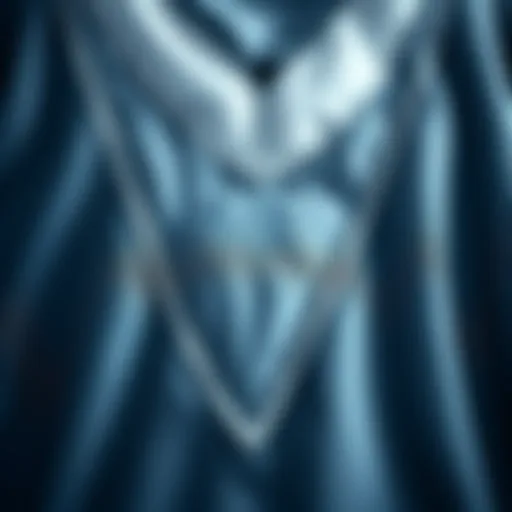Mastering Nail Art with Rhinestones and Charms
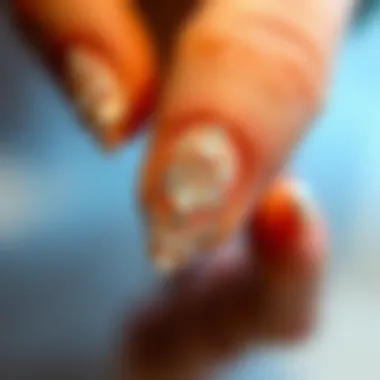

Intro
The allure of nail ribbons and charms has long captured the fancy of beauty enthusiasts and artists alike. They have migrated from mere accessories into legitimate pieces of artwork that adorn both fingertips and toes. This article dives into this fascinating world, exploring its origins, current trends, and practical application techniques, ensuring that you not only understand the how but also the why behind nail rhinestones and charms.
The journey begins with understanding the historical context of these embellishments. Often regarded as symbols of glamor and opulence, rhinestones have roots tracing back to the 18th century when crystals were applied to nail art as a status symbol. The evolution of styles over the decades illustrates an ever-changing canvas influenced by cultural shifts and technological advancements. This background sets the stage for appreciating their significance in contemporary fashion.
Moreover, it's essential to consider how personal expression plays a pivotal role in the popularity of these decorative elements. Nail art has evolved into a medium through which individuals express their unique personalities and styles. The article also focuses on practical aspects such as maintenance, application, and thoughtful removal, preventing potential pitfalls that come with using these dazzlers. Let’s discover how to enhance one's nail artistry by intricately weaving rhinestones and charms into personal fashion narratives.
Prologue to Nail Embellishments
Nail embellishments have come a long way from simple polishes to intricate designs that boldly express our personal style. Nail rhinestones and charms are standout additions that can transform a mundane manicure into a veritable work of art. This section will delve into the significance of these embellishments in nail art, emphasizing their aesthetic benefits and the myriad of creative possibilities they provide.
Nail rhinestones add sparkle and shine, whether they are minimalistic accents or arrange into elaborate patterns. They enhance the overall visual appeal of nails and reflect the wearer's unique personality. Charms, on the other hand, allow for thematic storytelling—each piece can represent a personal milestone or an artistic choice, making every nail design distinctive.
Considerations also play a vital role when deciding to incorporate these embellishments. The application process requires a steady hand and some specific tools, which can be daunting for beginners. Choosing high-quality materials is crucial, as subpar rhinestones or charms may not adhere well or can even cause skin irritations.
In this article, expect to uncover not just how to enhance your nails with rhinestones and charms but the historical context behind these beauty choices. We will touch on how trends evolve and how the significance of nails in culture reflects broader societal changes.
"Nail art is not only about the aesthetic—it's a canvas for personal expression, a touch of one’s character on fingertips."
With careful planning and proper techniques, both newcomers and seasoned enthusiasts can explore the transformative world of nail embellishments. Let’s dive deep into what nail rhinestones and charms are, and how they can elevate your nail game to the next level.
Diverse Styles of Nail Rhinestones
Nail rhinestones come in a kaleidoscope of styles, making them staples in the nail art community. Their significance goes beyond mere decoration; they reflect individuality and creativity. The diversity in styles enhances their application across different occasions, whether it’s a night out or a business meeting. Understanding the various kinds can help individuals choose the right embellishments to express their unique style.
Types of Rhinestones Available
Glass vs. Acrylic
When it comes to rhinestones, the choice between glass and acrylic can be a game-changer. Glass rhinestones offer a sublime clarity that can catch the light in a way that acrylic often can't. Their heavy-set nature provides a more luxurious feel, but they can chip easily if not applied correctly. Acrylic, on the other hand, is lightweight and flexible, making it a popular choice for intricate designs. While they might not reflect light as vividly as glass, acrylic rhinestones come in a wider variety of colors and shapes, making them a favorite for creative exploration. Thus, whether one opts for glass or acrylic often hinges on personal preference and the specific design goals.
Color and Clarity Options
The realm of colors and clarity in rhinestones adds another layer of excitement to nail design. Ranging from translucent hues to vibrant shades, the options are virtually limitless. Transparent rhinestones shine with an elegance that can elevate a simple nail design, while colored stones inject energy into the overall look. These choices enable personal expression, as individuals can select stones that reflect their moods or seasonal trends. However, pairing colors and clarity effectively can be tricky; sometimes, an overabundance of color can clash rather than complement. Striking the right balance is key to achieving a polished appearance.
Size Variations
Size variations in rhinestones can produce dramatically different effects in nail art. Small, delicate stones can be used to create intricate patterns, almost like fine jewelry adorning the nails. Larger stones, conversely, create bold statements and can serve as focal points in a design. The choice between sizes often influences not just the visual outcome but also the practicality of application. Smaller stones may require meticulous placement, while larger ones can be applied with relative ease. Understanding the implications of size is essential for achieving the desired aesthetic while maintaining the integrity of the nail design.
Popular Designs in Nail Art
Minimalist vs. Ornate
In the world of nail art, a stylistic divide often emerges between minimalist and ornate designs. Minimalist styles emphasize subtlety, using rhinestones very sparingly yet effectively. A single rhinestone placed at the base of the nail, for example, can allow for an elegant touch without overwhelming the overall look. Conversely, ornate designs can feature an abundance of rhinestones, creating a stunning visual spectacle. While the latter is eye-catching, it requires a solid grasp of balance; too much detail can easily go from chic to chaotic.
Trendy Patterns
Trendy patterns are the lifeblood of contemporary nail design, evolving with each season. Current trends might include geometric formations or florals, each with unique requirements for rhinestone placement. The versatility of rhinestones allows them to fit seamlessly into a multitude of patterns, whether it’s a playful polka dot effect or a sophisticated floral motif. However, as trends change rapidly, keeping up with the latest styles can be daunting. It's essential to constantly explore and expand one’s repertoire to stay relevant and inspired.
Design preferences often reveal deeper aspects of identity and style, making the art of nail decoration a form of personal expression.
In short, the diverse styles of nail rhinestones enrich the nail art landscape. From the material differences between glass and acrylic to the ongoing dance between minimalist and ornate design, these elements contribute significantly to both individual expression and trending aesthetics.
The Application Process
The process of applying nail rhinestones and charms is a foundation that can make or break your nail art design. Whether you’re an enthusiast or a professional stylist, understanding this application process is crucial for success in creating stunning and durable nail masterpieces. Not only does this process enhance the overall aesthetic appeal, but it also ensures that the embellishments remain securely in place throughout their wear. Moreover, taking time to properly execute the process contributes to the longevity of your manicure, saving time and preventing frustration down the road.
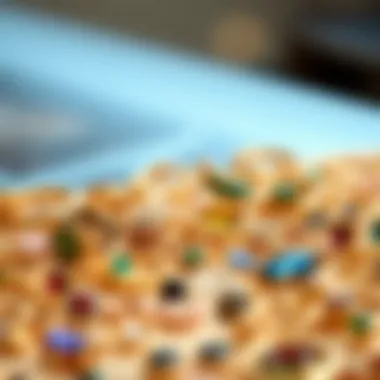

Essential Tools and Materials
Nail Adhesives
When it comes to nail rhinestones and charms, selecting the right adhesives can make all the difference. Nail adhesives are specially formulated to provide a strong hold that enables rhinestones and charms to remain intact through everyday activities. A key characteristic of quality nail adhesive is its ability to dry clear without leaving any trace, ensuring the design looks clean and polished.
One popular choice among nail artists is a gel nail glue. This formulation tends to offer a flexible bond, which adapts well to the natural movements of the fingers, thus preventing the risk of lifting or popping off your embellishments. However, an important consideration is that some might find acetone or other solvent-based removers a bit harsh when it comes to removing these adhesives. It’s essential to assess your own sensitivity and preference when selecting an adhesive for your nail art.
Brushes and Tweezers
Tools like brushes and tweezers play pivotal roles in applying rhinestones and charms. Brushes are invaluable for fine detailing, while tweezers help accurately position the embellishments where you want them.
A key feature of specialized nail art brushes is their precision. The fine bristles allow for the exact placement of adhesive, particularly on tiny stones. Meanwhile, tweezers crafted for nail art are designed with a precise tip to easily grip and maneuver small pieces without risk of damaging the stones themselves. However, both tools require a steady hand. Newcomers may need practice to get each placement just right, but the investment in good tools pays off in quality.
Step-by-Step Application Guide
Preparing the Nails
Before diving into the nail art phase, preparing your nails is an essential step that sets the tone for the entire application. Begin by cleaning your nails thoroughly to remove any oils or dirt. A good practice is to buff the nail surface lightly; this creates a texture that helps the adhesive stick better.
This preparation stage benefits not only the appearance but also the durability of the nail art. By ensuring a clean canvas, the chances of any mishaps during the application decrease significantly. However, a downside is that overly aggressive buffing can weaken the nail structure, so balance is key.
Placing the Rhinestones
Once the nails are prepared, it’s time to place the rhinestones. This stage requires a careful eye and steady hands. Apply a small bead of nail adhesive onto the nail where you wish to place the rhinestones, and use tweezers to grasp and position the stones accurately. A critical characteristic of this step is the timing; rhinestones should be pressed gently into the adhesive while it’s still wet.
A unique advantage of this process is that you can create varying designs, whether you want them clustered or spaced apart. However, patience is vital—rushing can lead to uneven spacing or misalignment of the stones, which detracts from the finished look.
Sealing the Design
Once everything is in place, sealing your design is an important finisher that shouldn’t be overlooked. Applying a top coat over the entire nail not only enhances shine but also provides a layer of protection against chipping and lifting. Typically, a gel top coat is a favored choice here due to its long-lasting effects.
The unique feature of this step lies in its ability to secure the entire design while also extending its life. However, it's important to note that applying too thick a layer may result in a cloudy finish instead of clarity. A careful application will ensure your work shines through beautifully, emphasizing the artwork you've created.
“Creating nail art is often a meticulous process, but taking the time to nail the application can produce breathtaking results that reflect your personal touch.”
While doing nail art can seem daunting, proper application techniques and tools can pave the way for creative expression. With the right knowledge of the application process, anyone can elevate their nail artistry from mundane to magnificent.
Incorporating Charms in Nail Design
In the landscape of nail art, charms add a layer of depth and personality that can transform a simple manicure into a masterpiece. Using charms allows for an expression of individuality, sync with current trends, or a nod to beloved themes in one's life. Designing with charms is more than mere decoration; it's about storytelling, making each nail a canvas of personal significance.
Choosing the Right Charms
Themes and Aesthetics
Themes play a crucial role in nail decoration, setting the tone for the entire design. Whether it's nature-inspired, whimsical, or trendy, the theme of the charms can elevate the aesthetic appeal significantly. For example, floral charms can echo the colors of spring, while geometric shapes might cater to a minimalistic fashion sense. A unique feature of themed charms is their ability to connect the wearer to specific memories or emotions. When charms resonate with personal stories, they become more than accessories; they convey a narrative through visual art.
A popular choice involves using charms that reflect cultural influences. Incorporating symbols from various cultures not only makes the design visually appealing but also serves to celebrate identity and heritage. However, designers must consider that not every theme is universally liked, which could make some designs less approachable for a broader audience.
Material Considerations
The materials of the charms can significantly influence the overall design as well as durability. Metal charms offer a certain elegance and tend to be more robust than plastic versions. However, they may feel heavier, which can be uncomfortable for some wearers. On the other hand, acrylic charms provide a lighter alternative that can come in a variety of colors and shapes, lending a playful vibe to the manicure.
It's important to factor in skin sensitivities when selecting materials. Charms made from hypoallergenic materials ensure both comfort and safety, especially for those with sensitive skin. Although plastic charms might be cheaper and more vibrant, they can show wear and tear quicker than metal charms. Finding a balance can optimize both aesthetic and practical considerations for nail art pursuits.
Placement and Arrangement
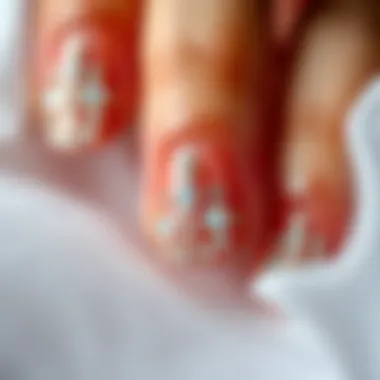

Balance and Symmetry
When it comes to incorporating charms, the placement is key. Balance and symmetry contribute significantly to the visual appeal of a nail design. By arranging charms evenly across the nail, one can create a polished look that feels harmonious. Striking a balance between larger and smaller charms can create focal points while adding interest without overwhelming the natural beauty of the nail itself.
A well-placed charm can catch the light beautifully, drawing attention without looking cluttered. On the flip side, haphazard placements can lead to chaotic designs that lack coherence. Thus, understanding balance not only enhances aesthetic pleasure but also instills a sense of artistry in the nail design.
Layering Techniques
Layering techniques in nail art can add richness and depth to the overall look. By strategically placing charms on top of various polish layers, one creates a multi-dimensional design that thrives off contrast. For instance, a base layer of glitter, topped with charms, can result in a sparkling effect that dances in the light.
Working in layers can also protect the charms from wear, prolonging the life of the nail art. Yet, it requires a delicate touch; too many layers might make the design bulky and impractical. Thus, designers should aim for balance: mixing visually appealing layers with practicality in mind to capture the essence of sophisticated nail art.
"Nail art is an expression of who we are; each charm, each color tells a story."
Choosing the right combination of themes, materials, placement, and layering can lead to breathtaking designs that do more than beautify nails—they represent a piece of the wearer's identity. Incorporating charms in nail art is an art form, evolving with trends and reflecting personal stories.
Maintaining Nail Embellishments
Nail embellishments, especially rhinestones and charms, are not just fleeting trends; they are an essential part of nail artistry that requires diligent maintenance. Proper care is fundamental to ensuring your nail decorations not only look stunning but also last longer. The benefits of maintaining these embellishments go beyond aesthetics; they can enhance your overall nail health, allowing for a longer lifespan of both your nails and their decorative elements. Ignoring these maintenance aspects can lead to aesthetic downfalls and unwanted damage, making it a critical area to address for anyone invested in the beauty of nail art.
Care Guidelines
Avoiding Damage
The act of avoiding damage to nail embellishments is crucial, as it helps preserve the sparkle and longevity of the designs. A key characteristic of this aspect is being mindful of the activities that can jeopardize your nails. For example, doing household chores without gloves can expose your nails to chemicals or physical harm, which affects both the nail and its adornments. By taking simple precautions, like wearing gloves when handling harsh cleaners, you can protect your intricate designs from peeling or dulling.
Additionally, understanding that heavy impact can easily dislodge rhinestones or charms is vital. Engaging in high-intensity activities, such as sports or manual labor, without taking care can lead to the loss of your carefully placed pieces. This doesn’t require a complete lifestyle overhaul, but rather a bit of forethought in daily routines—a small price to pay to maintain elegant nails that reflect your style.
Cleaning Techniques
Ensuring your nail embellishments remain clean is pivotal for maintaining their allure. Dust and oils can accumulate on nails, dulling their shine and making even the finest rhinestones appear lackluster. The primary characteristic of effective cleaning techniques is their gentleness. A popular choice for nail art enthusiasts is using a mixture of mild soap and water with a soft brush to delicately clean your nails. This allows for the removal of debris without scratching or damaging the embellishments.
Moreover, a unique feature of these cleaning methods is their accessibility—you don’t need specialized products to keep your nails looking pristine. Regular cleaning not only enhances the visual appeal of your nail art but also ensures the longevity of your rhinestones and charms. Periodically, applying a light top coat can also help seal and protect your creations from stains and dirt.|
Frequency of Reapplication
When it comes to nail embellishments, the frequency of reapplication can vary widely depending on a number of factors. Regular wear, lifestyle choices, and the environment play pivotal roles in determining how often you'll have to refresh your nail designs. For instance, if you frequently wash your hands or use hand sanitizers, you might find that your beautified nails require more frequent attention. Similarly, spending time in humid conditions can impact the adhesion of rhinestones and charms, leading to quicker wear.
While it’s tempting to change your nail art as trends evolve, it's also essential to consider the health of your natural nails. Taking breaks between applications allows your nails to breathe, preventing brittleness or weakness from over-adornment. Striking a balance between flair and maintenance will yield not only gorgeous results but also healthy nails, ready to dazzle anew after each rejuvenation.
Remember: A little caution goes a long way when it comes to maintaining the beauty and durability of your nail art.
The Role of Nail Art in Personal Expression
Nail art, particularly through the use of rhinestones and charms, has evolved into a significant form of self-expression. It's more than just a decorative practice; it allows individuals to communicate their personality, moods, and individual tastes. The beauty of this art lies in its versatility and the freedom it gives to the artist and the wearer alike.
Nail Art as a Reflection of Style
Cultural Influences
Cultural influences play a vital role in shaping nail art. They provide a rich palette from which styles evolve, drawing on traditions and practices from various communities worldwide. For instance, the colorful nail designs seen in Chinese culture often include intricate patterns and symbols that convey deeper meanings.
One key characteristic of cultural influences is their ability to bring historical context to modern nail designs. A tattoo artist might use henna patterns on nails, celebrating heritage while blending contemporary styles. This fusion fosters a sense of belonging while allowing for individual expression.
The unique feature of cultural influences in nail art is how they encourage a connection between the past and present. It not only highlights the legacies but also invites others to appreciate and adopt various global practices in personal grooming. However, it is important to consider the fine line between appreciation and appropriation; sensitivity matters widely in this context.
Individual Creativity
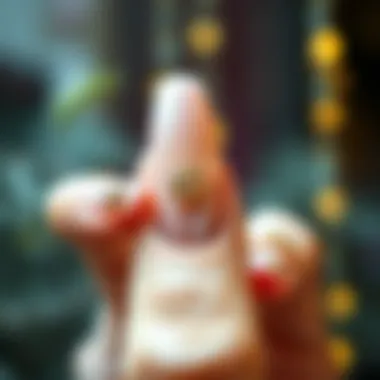

Individual creativity sparks innovation in nail design. Every person's nails tell a different story, reflecting their personal history and artistic vision. Channels like Instagram push the boundaries, showcasing designs that vary from the quirky to the avant-garde. This trait of individual creativity transforms what might be ordinary into something extraordinary.
The key characteristic here is innovation, where each nail becomes a canvas waiting to burst with colors and designs. Someone might choose to express a significant life change with a design that mimics flames, while another might opt for serenity with pastel floral patterns.
The advantage of this freedom is that it fosters a community of creators who inspire each other. There's also a risk though; the pressure to continuously stand out can lead to anxiety about nail appearance, especially in a world driven by social media validation.
The Influence of Social Media on Trends
The digital age has revolutionized how trends in nail art emerge and proliferate. Platforms like Instagram and Pinterest serve as visual galleries where stylists and amateur artists display their work. This visual-oriented social engagement creates a feedback loop that drives trends at unprecedented speeds, with viral designs appearing overnight.
Social media empowers individuals, giving them access to tutorials and design ideas that they might not have explored otherwise. The interaction fostered in this space drives creativity and aids in the evolution of nail art styles.
However, this influence is not without its drawbacks. Trends can shift abruptly, leaving some styles in the dust. Nail enthusiasts might feel the need to constantly adapt, which could dilute their personal style in favor of what's trending.
"Nail art has become such a dynamic form of expression, reflecting not just individual styles but also a plethora of cultural narratives that transcend borders."
As we navigate this vibrant community, understanding the balance between personal desires and trending fads can help maintain one's authentic voice in a sea of talent.
Potential Drawbacks and Considerations
While nail rhinestones and charms can undeniably enhance the beauty of nail art, it is essential to approach their use with a critical eye. Understanding the potential downsides—like allergies and difficulties in removal—can help ensure a smoother experience when incorporating these decorative elements into your style. Awareness of these risks allows for a more informed decision-making process, leading to greater satisfaction in the long run and helping nail artists and enthusiasts alike to navigate the intricate world of nail embellishments with confidence.
Allergies and Sensitivities
When it comes to nail accessories, allergies are a very real concern. Many individuals might experience reactions to certain materials used in rhinestones and charms. For example, metals like nickel can cause irritation for some people, leading to redness, swelling, or even blisters. Similarly, certain adhesives may also contain chemicals that can trigger sensitivities. It is crucial to pay attention to any signs your body might give and perform a patch test if unsure about a product.
To minimize negative reactions, opt for hypoallergenic materials. These options are designed with sensitive skin in mind and can offer a safer way to enjoy nail art without compromising on style.
Removal Process Considerations
When you’ve adorned your nails with rhinestones and charms, it’s only a matter of time before you want or need to remove them. This process can be quite tricky, and proper care is necessary to avoid damaging your natural nails. Here are a couple of key aspects to consider in this area:
Tools for Safe Removal
Using the right tools becomes paramount when it’s time for the intricate art of nail embellishments to come off. One of the most beneficial choices for effective removal is an acetone-based nail polish remover. This solvent can dissolve most adhesives effectively, easing the removal process without much hassle. Conversely, using improper tools, like regular pliers or harsh objects, can risk both the health of your nails and the surrounding skin.
Another recommended option is a gentle, non-acetone remover. Though it might take a bit longer, it’s often less harsh on the nails and skin, making it a popular choice for those concerned about overexposure to strong chemicals. Once you’ve selected your remover, keep an eye on your natural nails throughout the process. If you notice signs of damage or irritation, it might be time to switch approaches.
Protecting the Natural Nail
Protecting your natural nails during the removal process is just as critical as removing the embellishments itself. Strong removers can dry out the nail bed and lead to brittleness, making subsequent applications of nail art much more difficult. To counteract this, consider using a nourishing cuticle oil or nail strengthener post-removal. These products can restore moisture and strength to your nails, keeping them healthy for your next artistic endeavor.
Additionally, take your time during the removal process. Rushing through can lead to unintentional damage. By treating your nails with care, you ensure they remain intact for your next round of fabulous nail art. Attention to these specifics not only enhances your overall experience but also promotes healthier nails in the long run.
Ending and Future Perspectives
The realm of nail rhinestones and charms stands at a fascinating junction of artistry and fashion, continually evolving to reflect personal expression and societal trends. This article has aimed to shed light on various facets, from the historical roots of nail embellishments to the intricacies of application techniques and maintenance strategies. Understanding these elements not only enriches appreciation for nail artistry but also guides individuals, stylists, and retailers in navigating this vibrant world.
Evolving Trends in Nail Embellishments
The landscape of nail embellishments has seen dynamic shifts over recent years. One key trend is a move towards sustainability in materials used for both rhinestones and charms. Biodegradable options and eco-friendly adhesives are becoming increasingly popular among conscious consumers. This transition not only aligns with broader environmental movements but also invites innovation in design and application.
In terms of style, there's a noticeable gravitation towards minimalistic designs. Yes, bold statements still have their place, but the sleek aesthetic of strategically placed rhinestones has gained ground, providing a sophisticated alternative for many. Additionally, colors are evolving too; while classic shades like clear and silver remain timeless, unexpected hues such as pastels and even neons are appearing more frequently, spicing up traditional options.
Another trend worth noting is the influence of fashion shows and social media platforms. Platforms like Instagram and Pinterest serve as amplifiers for fresh nail art ideas, showcasing trends that can go viral within days. Followers often replicate not only designs but also techniques they see on influencers’ pages. As a result, nail artists are encouraged to stay ahead of the curve, continuously experimenting and honing their craft.
The Lasting Appeal of Nail Art
Nail art, particularly the inclusion of rhinestones and charms, transcends mere vanity; it embodies personal storytelling. Each design chosen can represent an individual’s aspirations, tastes, or social identities. For many, this form of self-expression is an accessible way to showcase their creativity while enhancing their overall look. The diverse options available—from understated elegance to intricate beadwork—ensure that there’s something for every preference.
The community aspect surrounding nail art is also powerful. Enthusiasts often share their creations and inspirations through various online platforms, sparking conversations and connections that go beyond just nails. This communal sharing fosters a supportive environment where ideas flourish. One might say, nails have become a canvas for deeper narratives that engage onlookers, stirring curiosity and admiration.
As nail art continues to flourish, it is evident that rhinestones and charms will remain integral to its evolution, reflecting not only style but also individual narratives.



